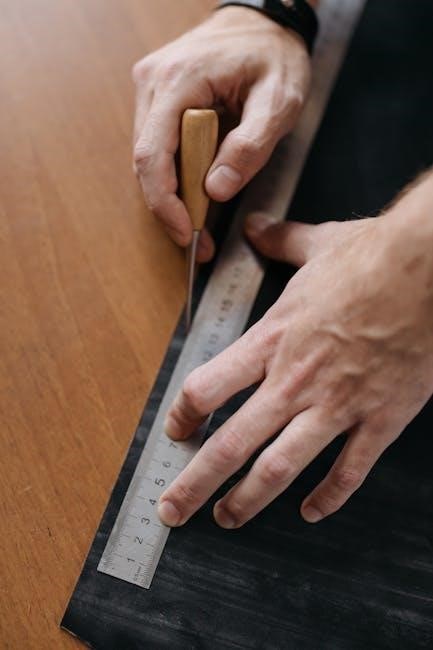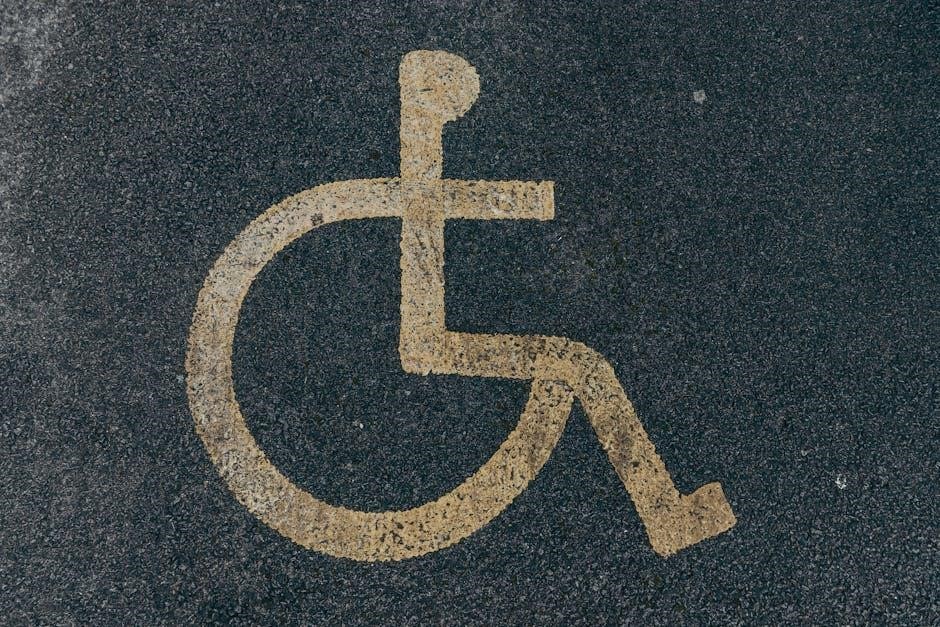A proper wheelchair measurement guide ensures optimal comfort, support, and mobility for users. This guide provides step-by-step instructions to accurately measure and fit a wheelchair, focusing on key dimensions and user needs for the best possible fit.
Understanding the Importance of Proper Wheelchair Measurements
Proper wheelchair measurements are essential for ensuring comfort, safety, and optimal mobility. A well-fitted chair prevents health issues like pressure sores and poor circulation, while also enhancing independence. Incorrect measurements can lead to discomfort, reduced mobility, and increased risk of medical complications. Additionally, a correctly sized wheelchair improves posture, reduces fatigue, and allows for better navigation in various environments. Proper fitting also ensures the chair’s durability and longevity, avoiding costly adjustments or replacements. By prioritizing accurate measurements, users can enjoy a wheelchair that supports their lifestyle and promotes overall well-being. This guide helps users and caregivers understand the critical role of precise measurements in selecting the right wheelchair.

Key Measurements for a Wheelchair
Key measurements include seat width, depth, backrest height, armrest length, and footrest dimensions. These dimensions ensure proper fit, comfort, and functionality for the user.

Seat Dimensions: Width and Depth
Accurate seat dimensions are crucial for comfort and mobility. The seat width should accommodate the user’s hips comfortably, with a little extra space for ease of movement. The depth should support the thighs without causing pressure points. Proper measurements prevent issues like poor posture or restricted circulation. Ensure the user sits upright with feet flat on the floor or footrest. For optimal fit, measure from the widest part of the hips for width and from the back of the buttocks to the back of the knee for depth. This ensures the wheelchair supports the user’s body effectively.
Backrest Height and Angle
The backrest height and angle are essential for proper posture and support. The height should align with the user’s shoulder level, ensuring the shoulders remain relaxed. Measure from the seat base to the top of the backrest, typically ranging between 25-30 inches for standard chairs. The angle should be adjustable to accommodate the user’s comfort, usually between 90-110 degrees. A correct backrest setup prevents slouching and promotes good spinal alignment. Incorrect measurements can lead to discomfort, fatigue, or even long-term health issues like back pain. Always consider the user’s specific needs, such as lumbar support or additional padding, to enhance comfort and usability.
Armrest Height and Length
Armrest height and length are crucial for comfort and proper posture. Measure from the elbow to the top of the seat cushion, ensuring the shoulders remain relaxed and the arms hang straight. The height should allow the user to sit with elbows at a 90-degree angle, while the length should be proportional to the user’s body size. Adjustable armrests can accommodate different needs, such as desk use or transfers. Incorrect measurements may lead to discomfort, poor posture, or difficulty maneuvering the wheelchair; Properly fitted armrests enhance stability, reduce strain, and promote overall usability, ensuring the wheelchair meets the user’s functional and comfort requirements effectively. Precision is key for optimal support and mobility.
Footrest and Legrest Measurements
Accurate footrest and legrest measurements are essential for comfort and proper posture. Measure the thigh length from the rearmost point of the buttocks to the hollow of the knee, then subtract about 30 mm for the legrest length. The footrest height should be measured from the floor to the sole of the foot when the leg is extended, ensuring the feet are supported without pressure on the thighs. Proper fitting prevents pressure sores and improves circulation. Adjustable features allow customization to meet individual needs, ensuring the wheelchair promotes both comfort and mobility effectively. Correct measurements here are vital for long-term user well-being and ease of use. Attention to detail ensures optimal support and functionality, making daily activities more manageable and enjoyable.

How to Measure the Wheelchair User
Measuring the user involves assessing height, weight, posture, and body dimensions to ensure proper wheelchair fit. Key areas include hip and thigh length, shoulder, and elbow measurements.
Measuring the User’s Height and Weight
Measuring the user’s height and weight is the first step in determining the appropriate wheelchair size. Height is measured while the user is standing upright, ensuring proper posture. Weight is recorded using a reliable scale. These measurements help assess the user’s body proportions and ensure the wheelchair’s structural integrity and weight capacity are suitable. Accurate height and weight data are essential for preventing discomfort and potential health issues, such as pressure sores or poor posture. Ensure the user wears lightweight clothing and no shoes during measurement for precise results. This foundational data guides other measurements, like seat dimensions and backrest height, ensuring a tailored fit for optimal comfort and mobility.
Assessing Postural Requirements

Assessing postural requirements involves evaluating the user’s natural sitting position to ensure proper alignment and support. This includes measuring the pelvis, spine, and muscle tone to determine if additional support, such as lateral or lumbar pads, is needed. The user should sit upright with feet flat on the floor or a footrest, keeping shoulders relaxed. Postural assessment helps identify any asymmetries or deformities that may require specialized seating solutions. Correct posture during measurement is crucial to prevent discomfort, pressure sores, or long-term health issues. A mirror or assistant can help verify proper alignment. This step ensures the wheelchair is tailored to the user’s unique needs for optimal comfort and mobility.
Measuring Hip and Thigh Length
Measuring hip and thigh length is essential for ensuring proper fit and comfort. The thigh length is measured from the rearmost point of the buttocks to the back of the knee. To do this, the user should sit upright with feet flat on the floor or footrest. A flexible tape measure is used to take this measurement, ensuring accuracy. Hip width is measured across the widest part of the hips while sitting. These measurements help determine the appropriate seat width and depth. Accurate hip and thigh measurements ensure the wheelchair fits comfortably, preventing pressure sores and discomfort. Double-checking these measurements is crucial for optimal fit and mobility. Proper fitting ensures the user can sit comfortably and maintain good posture.
Shoulder and Elbow Measurements
Shoulder and elbow measurements are crucial for determining the optimal height and position of the armrests. To measure elbow height, the user should sit upright with their shoulders relaxed and arms hanging straight down. The measurement is taken from the back of the elbow to the top of the seat cushion. This ensures the armrests are positioned correctly to support the arms without causing strain. Proper shoulder and elbow measurements help maintain good posture, prevent discomfort, and ensure the user can interact with their environment comfortably. Accurate measurements are essential for a comfortable and functional wheelchair fit. This step ensures the chair supports the user’s upper body effectively.

Additional Considerations for Wheelchair Fitting
Ensure the wheelchair’s weight capacity matches the user’s needs. Check the durability of materials and consider adjustability for future changes. Prioritize comfort and pressure distribution for long-term use.

Weight Capacity and Durability
Ensuring the wheelchair’s weight capacity matches the user’s needs is crucial for stability and safety. Exceeding the limit can compromise structural integrity. Durability of materials, such as steel or aluminum frames, impacts longevity. Lighter frames may sacrifice strength, while heavier ones offer greater stability. Consider the user’s lifestyle and mobility requirements when selecting materials. Proper fitting and alignment also prevent excessive wear and tear. Regular maintenance, like checking bolts and tires, ensures durability. A sturdy, well-fitted wheelchair reduces the risk of breakdowns and enhances overall performance. Always prioritize quality and reliability to meet the user’s long-term mobility needs effectively.
Adjustability of Components
Adjustability in wheelchair components is essential for ensuring a tailored fit and accommodating changing user needs. Key features include variable seat height, armrest adjustability, and footrest adaptability. These adjustments allow the wheelchair to adapt to different body types and postures, promoting comfort and usability. Proper alignment of components like the seat depth and backrest angle can significantly enhance mobility and reduce the risk of discomfort or medical issues. Additionally, adjustable features enable the wheelchair to meet the user’s specific lifestyle requirements, such as navigating tight spaces or participating in physical activities; Ensuring components are easily modifiable ensures long-term satisfaction and optimal performance.
Comfort and Pressure Distribution
Comfort and pressure distribution are critical for preventing discomfort, pressure sores, and long-term health issues. A well-fitted wheelchair ensures even weight distribution, reducing pressure points. The seat cushion and backrest play key roles in maintaining proper posture and comfort. Materials like gel or foam cushions can enhance pressure distribution. Additionally, adjustable features such as tilt and recline functions can help redistribute weight, improving circulation and reducing fatigue. Proper fitting also ensures the user’s posture is supported, minimizing the risk of pressure-related complications. Regular assessments and adjustments are essential to maintain optimal comfort and prevent potential health risks associated with prolonged wheelchair use.

Common Mistakes in Wheelchair Measurement
Common mistakes include incorrect posture during measurement, ignoring weight distribution, and overlooking adjustable features. These errors can lead to poor fit and discomfort for the user.
Incorrect Posture During Measurement
Incorrect posture during measurement is a common mistake that can lead to inaccurate wheelchair fitting. Users often slouch or lean forward, which skews key dimensions like seat depth and backrest height. This can result in a chair that doesn’t properly support the spine or pelvis, causing discomfort and potential health issues. To avoid this, ensure the user sits with a neutral spine, shoulders relaxed, and feet flat on the floor or footrest. Proper posture ensures measurements reflect the user’s true needs, preventing issues like pressure sores or poor mobility. Always guide the user into the correct position before taking any measurements for optimal accuracy and comfort.

Ignoring Weight Distribution
Ignoring weight distribution is another frequent error in wheelchair measurement. Failing to account for how the user’s weight is distributed can lead to an ill-fitting chair, causing instability and discomfort. Uneven weight distribution may result in the chair tipping or putting excessive pressure on certain areas, increasing the risk of pressure sores. Proper assessment involves ensuring the chair is balanced and supports the user’s weight evenly. This requires measuring the user’s seated position and adjusting the chair’s components to align with their center of gravity. Neglecting this step can compromise both safety and comfort, making it essential to prioritize weight distribution during the fitting process.
Overlooking Adjustable Features
Overlooking adjustable features is a common mistake in wheelchair measurement. Many chairs come with adjustable components like seat height, armrests, and footrests, which are crucial for a proper fit. Failing to consider these adjustments can lead to a chair that doesn’t accommodate the user’s posture or mobility needs. For instance, adjustable armrests can relieve shoulder strain, while a modifiable seat height ensures proper foot placement. Ignoring these features may result in discomfort or limited mobility. It’s essential to evaluate and utilize these adjustments during the measurement process to ensure the chair is tailored to the user’s specific requirements and promotes long-term comfort and functionality.
Proper wheelchair measurement is crucial for ensuring comfort, mobility, and long-term health. By following the guide, users can avoid common mistakes and select a chair that meets their specific needs. Always prioritize weight capacity, adjustability, and pressure distribution to prevent medical issues like pressure sores. Regularly reassess and adjust the wheelchair as the user’s needs change. Consulting a professional can provide personalized recommendations. Remember, a well-fitted wheelchair enhances independence and quality of life. Take the time to measure carefully and explore all options to find the perfect fit for optimal usability and comfort.